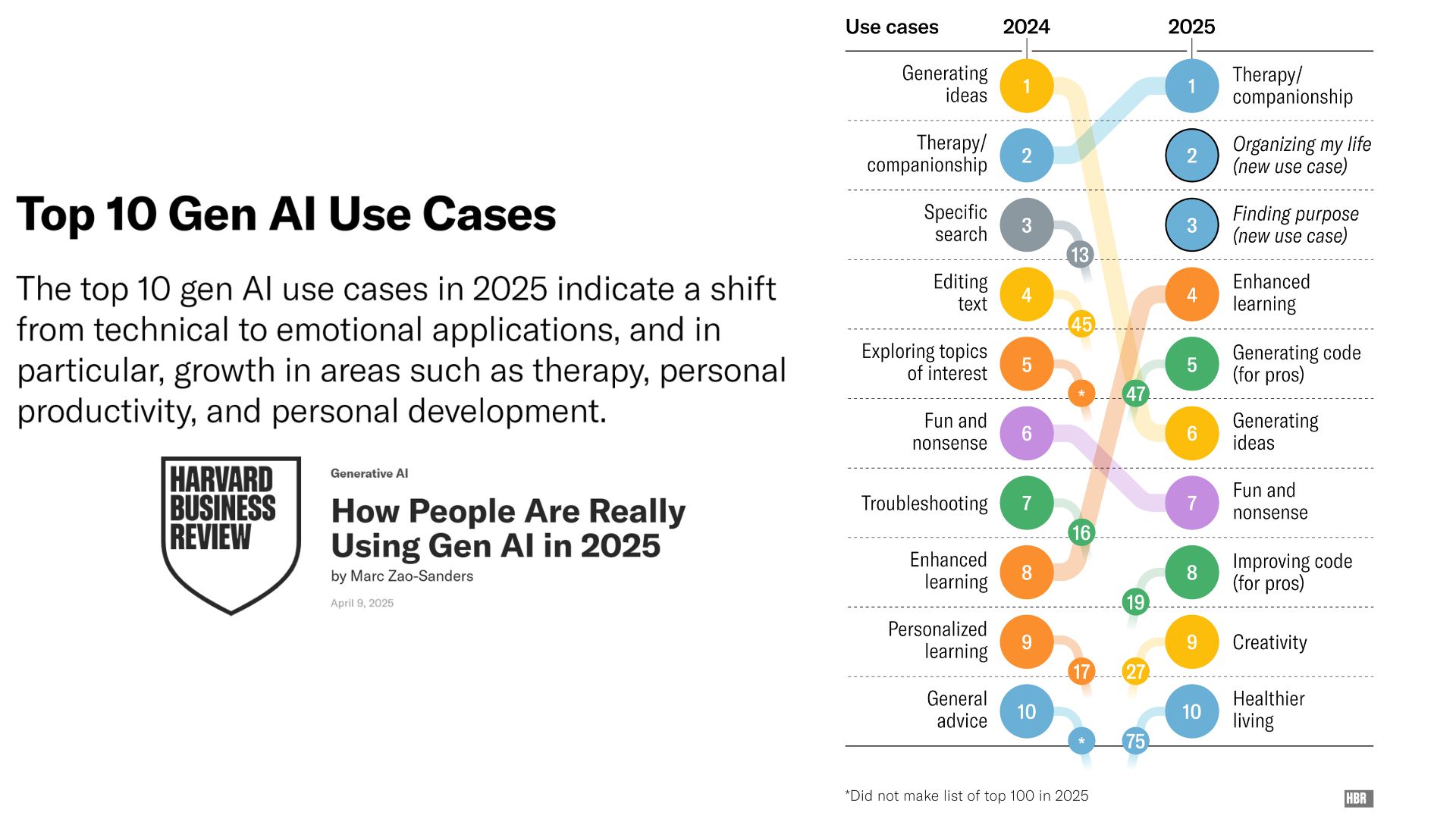When we talk about artificial intelligence, the conversation often turns toward automation, productivity, or cutting-edge research. But the reality of how people use generative AI in their daily lives is much more human.
In an April 9, 2025 Harvard Business Review article, Marc Zao-Sanders shared new findings about the top three reasons people turn to generative AI: therapy/companionship, organizing life, and finding purpose. His research points to an unexpected but deeply revealing truth—AI is not just a tool for business or technology, but a resource people reach for in moments of stress, loneliness, and searching.
Therapy and Companionship
Zao-Sanders’ study highlights how AI is increasingly used as a stand-in for emotional support. One South African respondent explained that limited access to mental healthcare—just one psychologist for every 100,000 people—makes AI a critical lifeline. Generative AI, available on any smartphone, provides immediate comfort without barriers of cost or geography.
This raises both opportunity and concern. On one hand, AI can reduce isolation and help people feel heard. On the other, it cannot replace professional care, nor can it guarantee data privacy. As Zao-Sanders’ research reminds us, technology often runs ahead of regulation, leaving users exposed if they don’t fully understand how the systems work.
Organizing Life
Generative AI also functions as a digital assistant for an overwhelmed society. Whether drafting emails, creating schedules, or generating wellness routines, AI alleviates the constant juggle between personal and professional obligations. For a parent managing remote work while caring for children, this organizational support can feel nothing short of transformational.
But again, there’s a catch: users who don’t understand AI’s limits may accept flawed or biased suggestions as fact. AI is powerful—but it requires a literate user to apply judgment, filter outputs, and safeguard their own decision-making.
Finding Purpose
Perhaps the most surprising finding is that people now use AI to explore meaning and purpose. With societal shifts weakening traditional structures like religion, lifelong careers, and multigenerational families, individuals are increasingly experimenting with AI for reflection. Some ask ChatGPT to conduct Socratic dialogues, while others feed it journal entries to analyze emotions or spot behavioral patterns.
These uses highlight both the adaptability and the illusion of empathy that AI can project. While AI cannot truly “understand” us, it can generate responses that feel validating. This makes literacy—knowing how to engage responsibly with these tools—more important than ever.
Why the LDI AI Literacy Microcredential Matters
At NJIT’s Learning & Development Initiative (LDI), our AI Literacy Microcredential directly addresses these trends. The course equips learners not only to use generative AI, but to critically understand how it shapes human interaction, personal organization, and even the search for meaning.
By grounding learners in practical skills, ethical awareness, and critical evaluation, the AI Literacy microcredential helps people avoid over-reliance, protect their privacy, and apply AI in ways that enhance rather than diminish their lives. In a world where companionship, organization, and purpose are increasingly tied to AI, knowing how to navigate these tools becomes as essential as knowing how to read or write.
Marc Zao-Sanders’ research makes one point abundantly clear: generative AI is no longer just a technology—it is a companion, an organizer, and, for some, a guide. But without literacy, these same qualities can mislead or even harm. The LDI AI Literacy microcredential ensures that learners step into this AI-shaped world with knowledge, confidence, and responsibility.
In an April 9, 2025 "How People Are Really Using Gen AI in 2025" article published in the Harvard Business Review , Marc Zao-Sanders
To download the full report via PDF, click here.

